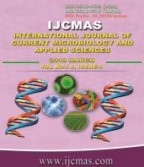


 National Academy of Agricultural Sciences (NAAS)
National Academy of Agricultural Sciences (NAAS)

|
PRINT ISSN : 2319-7692
Online ISSN : 2319-7706 Issues : 12 per year Publisher : Excellent Publishers Email : editorijcmas@gmail.com / submit@ijcmas.com Editor-in-chief: Dr.M.Prakash Index Copernicus ICV 2018: 95.39 NAAS RATING 2020: 5.38 |
The present investigation was carried out to find faster chemical methods to determine genetic purity in ten pigeon pea varieties. The faster methods are Ferrous Sulphate test, Sodium hydroxide test, peroxidase test, seedling growth response to GA3, kinetin and 2-4D. Histogram using pixel luminance in ferrous sulphate test based on the grey scale produces values ranging from 17377 to 90616 which can be used to distinguish pigeon pea varieties. Similarly, sodium hydroxide test produced six coloured palette based on RGB values can distinguish varieties in pigeon pea. Also in peroxidase test, values for all ten pigeon pea varieties based on absorbance (0.252-2.372), peroxidase enzyme activity (0.791-7.442 IU/mg) and peroxidase enzyme volume (1.581-14.883 U/g) can be used for distinguishing varieties. Among the seedling growth response tests, in GA3 test two varieties Asha (-2) and GC-11-39 (-6) were not responded and were recorded lowest values than the control. But remaining varieties can be distinguished as medium to high response types. Also in kinetin test two varieties not responded (GRG-811 and Asha) and all the other varieties can be distinguished based on this test. In case of 2-4D test all the varieties were recorded as susceptible. The co-efficient of variation for all the three tests based on the increase in coleoptile length over the control was ranged from 0.20 (Kinetin test) to 0.37 (GA3 test).
 |
 |
 |
 |
 |